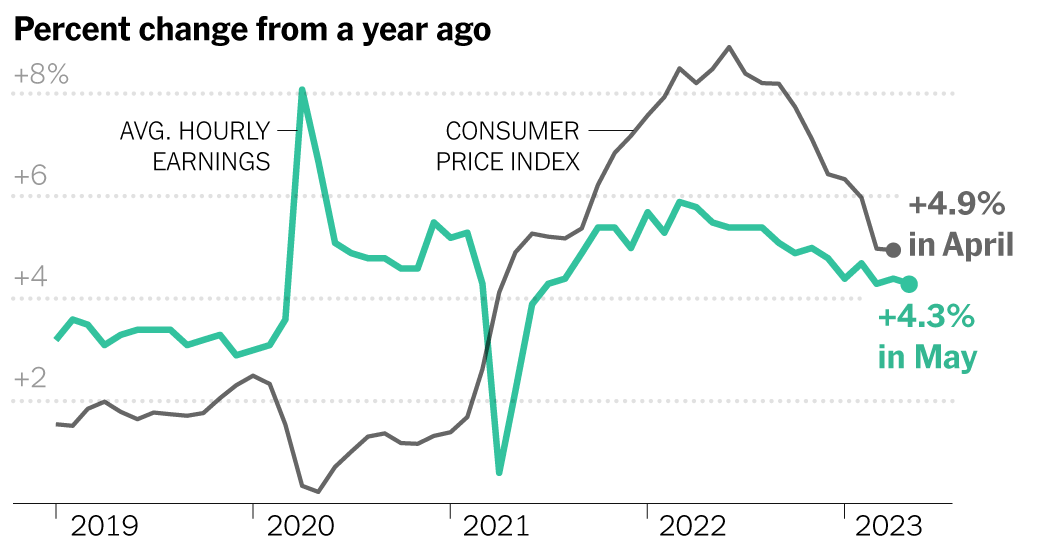Federal Reserve officials have indicated they could keep rates stable at their upcoming meeting in June — pausing after a series of 10 consecutive rate hikes to give themselves time to see how the economy develops.
Even after new jobs data released Friday showed strong hiring in May, the Fed could stay on track for that more patient approach. While employers continued to add workers, other aspects of the report — including a rise in unemployment and a slowdown in wage growth — clouded any signal coming out of the data.
Investors seemed to think the employment report could complicate the Fed’s impending decision, but not so much as to change the game. Wall Street raised the likelihood of a rate hike this month after the report, based on prices in the financial markets. Yet they still only saw a one in three chance of an increase.
Central bankers raised interest rates from last month to a range of 5 to 5.25 percent, a sharp increase from near zero in early 2022. they can assess how the economy is absorbing the big policy changes they’ve already made and the impact of other developments, including the consequences of the recent banking turmoil.
Higher interest rates cool the economy by making it more expensive to borrow to buy a house or finance a car, but it takes time to take full effect. In response to higher borrowing costs, companies are gradually pulling back on expansion plans and slow hiring, which in turn leads to weaker wage growth and a slower overall economy.
That’s why labor market data is so crucial: it’s a referendum on how well policies are working to cool the economy, and they indicate whether inflation is likely to slow. Officials fear rapid wage increases could prompt companies to continue raising prices rapidly while trying to prevent higher labor costs from eating into profits.
Friday’s numbers offered both good and bad news for policymakers. The unemployment rate rose to 3.7 percent, from 3.4 percent in the previous reading, and wage growth slowed slightly. Still, May added 339,000 jobs, far more than economists had expected and an increase from the previous month.
The conflicting evidence – of softening on the one hand and resilience on the other – was due in part to differing results from the two different surveys used in the monthly employment report. But the split-screen of the labor market may make the Fed’s job of figuring out how to set policy more challenging, at least in the margins.
“Given this upward surprise in payrolls, I still think the Fed has more room to tighten,” said Gennadiy Goldberg, an interest rate strategist at TD Securities. “They have a difficult conversation ahead of them in June.”
But some Fed officials have already said they prefer to delay a rate hike in June so they have more time to see how higher borrowing costs and heightened uncertainty combine to constrain the economy. Patrick T. Harker, the president of the Federal Reserve Bank of Philadelphia, said earlier this week that he is “definitely in the camp thinking about skipping any increase in this meeting.”
And in a signal that a pause may be imminent, a key official underlined earlier this week that it doesn’t mean the Fed is done raising rates if the meeting doesn’t pass rate hikes.
“A decision to hold our policy rate constant at an upcoming meeting should not be interpreted as a sign that we have peaked for this cycle,” said Philip Jefferson, a Fed governor selected by President Biden to be Vice Chairman of the Federal Reserve. become an institution. said in a speech on May 31.
“Indeed, skipping a rate hike at an upcoming meeting would allow the committee to see more data before making decisions on the extent of additional policy tightening,” Mr Jefferson added. The Fed Vice Chairman has historically been a key communicator for the institution, broadcasting how core officials feel about the future policy path.
Julia Coronado, founder of MacroPolicy Perspectives, said she didn’t think the surge in overall jobs would be enough to deter Fed officials from quitting at their June 13-14 meeting. The report’s other details — from hours worked to the unemployment rate — confirmed that the economy is cooling, she said.
The big gains in payrolls “is the anomaly here,” she said. “Everything points to a cooling of the labor market.”

